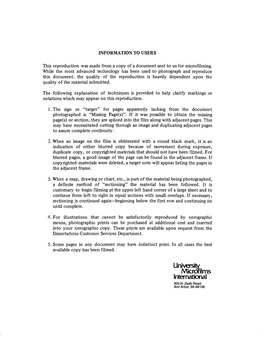| dc.contributor.author | Penn, David A. | en_US |
| dc.date.accessioned | 2013-08-16T12:29:19Z | |
| dc.date.available | 2013-08-16T12:29:19Z | |
| dc.date.issued | 1984 | en_US |
| dc.identifier.uri | https://hdl.handle.net/11244/5320 | |
| dc.description.abstract | The last portion of the study offers an empirical test of the hypotheses generated by the model. Ordinary least squares equations are estimated, using the number of water rights cases as an indicator of defining and enforcing activity. The independent variables are an index of streamflow as an indicator of the supply of water diversions, and the value of crops per acre as an indicator of the demand for water. The independent variables account for a large proportion of the variation in water rights litigation. | en_US |
| dc.description.abstract | The second portion of the study provides an historical context of the development of property rights in the West, focusing on the experience in Colorado. The evolution of property rights is analyzed, given the actual economic and ideological constraints and motivations existing at the time. | en_US |
| dc.description.abstract | This study represents a limited step towards addressing the problems of the continuous development of property rights in natural resources. First, a model of the evolution of water rights in the West is developed. In the model, the specification of property rights in water is treated as a continuous variable, ranging from completely non-exclusive to completely exclusive. The particular position on the continuum depends on the benefits of increasing the level of exclusivity relative to the costs. As the net benefits of increasing water right exclusivity increase, the model predicts greater property rights defining and enforcing activity. | en_US |
| dc.description.abstract | The quantitative and historical evidence suggests that water rights exhibit a tendency to develop efficiently, but that this tendency is constrained by the costs of defining exclusive rights to water and by ideology. The costs of defining exclusive property rights depends on the physical nature of the resource and on the expense of litigation and lobbying. Ideological influences appear to have developed in response to monopolistic practices by corporate canals. | en_US |
| dc.description.abstract | In the early property rights literature, the specification of property rights was usually dichotomized: property rights were either completely non-exclusive or they were treated as totally private and exclusive. Most of the literature was concerned with assessing the relative efficiency of these polar forms; the problem of the development of property rights received less attention. | en_US |
| dc.format.extent | ix, 206 leaves : | en_US |
| dc.publisher | The University of Oklahoma. | en_US |
| dc.subject | Economics, Agricultural. | en_US |
| dc.subject | Law. | en_US |
| dc.subject | Water rights. | en_US |
| dc.subject | History, United States. | en_US |
| dc.title | An analysis of the economic and ideological factors involved in the development of rights to water in the West : | en_US |
| dc.type | Thesis | en_US |
| dc.thesis.degree | Ph.D. | en_US |
| dc.note | Source: Dissertation Abstracts International, Volume: 46-01, Section: A, page: 0220. | en_US |
| ou.identifier | (UMI)AAI8505913 | en_US |
| ou.group | College of Arts and Sciences::Department of Economics | |
